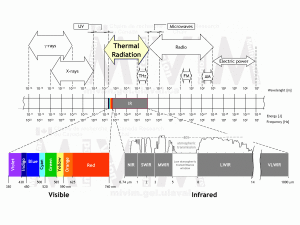Infrared
The term “Infrared” means a portion of the electromagnetic spectrum that lies “beyond the red”, with longer wavelengths then of the color red (in the visible spectrum) and shorter wavelengths than microwave.
The discovery of infrared (IR) dates back to 1800. Many important discoveries were made in the following decades up to the present day, with infrared detectors fixed on aircrafts and satellites for a continuous scanning of our planet and of the deep Universe.
Infrared
The discovery of infrared (IR) dates back to 1800 from physicist William Herschel; as a result of experimentation with thermal sunlight through a prism, Herschel noticed that the temperature in the area being not illuminated by visible light, yet in proximity to the red band which was higher compared to that of other areas not illuminated. There was evidence that some specific solar radiation is not visible.
The light (visible) from solar radiation is an electromagnetic radiation between 0.35 and 0.74 micron. The radiation range with a wavelength between 0.74 and 0.8 micron is called “photographic infrared”, while those with a wavelength greater than 0.8 micron are called “thermal infrared” and are used for “thermal vision”.
Normally, in the construction field, the sensors are used and calibrated between 7 and 14 micron which allows for an investigation of the temperatures between -40 °C and +100 °C with an extreme precision.
 Every object with a temperature above absolute zero (0 Kelvin = -273.15 ° C ) emits radiation into surrounding space; this radiation can be detected by the camera and converted into electric signal, and from this, into a digital image. It is not necessary, therefore, for the operator to come into close contact with the objects in order to perform the measurements, indeed the emitted infrared radiation is detected, measured and recorded, even through the space of a vacuum. Non-Destructive Testing utilizing the Infrared method is signified in this way.
Every object with a temperature above absolute zero (0 Kelvin = -273.15 ° C ) emits radiation into surrounding space; this radiation can be detected by the camera and converted into electric signal, and from this, into a digital image. It is not necessary, therefore, for the operator to come into close contact with the objects in order to perform the measurements, indeed the emitted infrared radiation is detected, measured and recorded, even through the space of a vacuum. Non-Destructive Testing utilizing the Infrared method is signified in this way.
Non-Destructive Testing (NDT) signifies tests, exams, and surveys whose methods do not alter the material, and do not require the destruction or removal of samples from the object in question.
The most commonly used methods are based on the ultrasonic (UT), X- and gamma- ray radiation (RT), vibration, electromagnetic induction (MT), with penetrating liquid (PT); as well as methods such as thermography (TT), endoscopy, strain gauge (ST), the eddy current (ET), visual examination (VT) and so on.
The tests results, using these methods, are the basis for assessment of a product’s quality, for the examination of component integrity, and for diagnostics and research into the causes of machinery and equipment troubleshooting.


